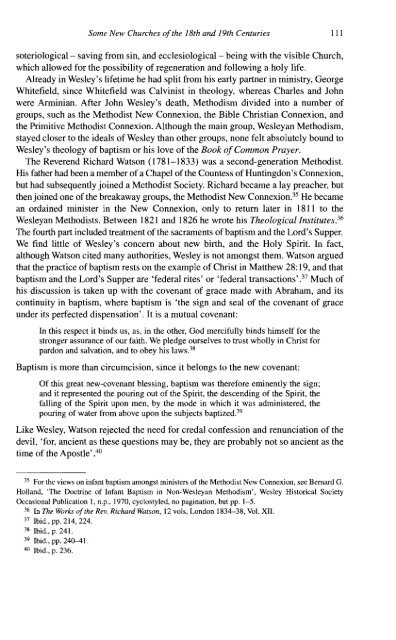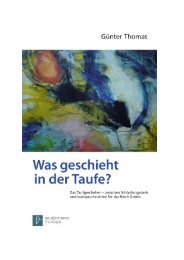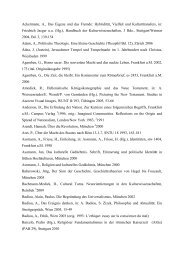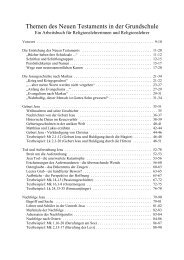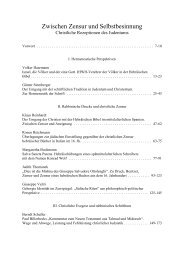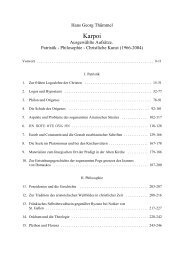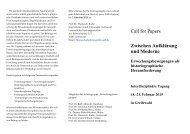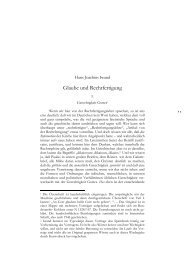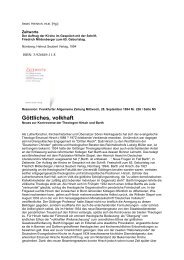The Radical Reformation Tradition: Anabaptists, English Separatists ...
The Radical Reformation Tradition: Anabaptists, English Separatists ...
The Radical Reformation Tradition: Anabaptists, English Separatists ...
- No tags were found...
You also want an ePaper? Increase the reach of your titles
YUMPU automatically turns print PDFs into web optimized ePapers that Google loves.
Some New Churches ofthe 18th and 19th Centuries 111soteriological saving from sin, and ecdesiological- being with the visible Church,which allowed for the possibility of regeneration and following a holy life.Already in Wesley's lifetime he had split from his early partner in ministry, GeorgeWhitefield, since Whitefield was Calvinist in theology, whereas Charles and Johnwere Arminian. After John Wesley's death, Methodism divided into a number ofgroups, such as the Methodist New Connexion, the Bible Christi an Connexion, andthe Primitive Methodist Connexion. Although the main group, Wesleyan Methodism,stayed doser to the ideals of Wesley than other groups, none feIt absolutely bound toWesley's theology ofbaptism or his love ofthe Book ofCommon Prayer.Tbe Reverend Richard Watson (1781-1833) was a second-generation Methodist.His father had been a member of a ChapeI ofthe Countess of Huntingdon's Connexion,but had subsequently joined a Methodist Society. Richard became a lay preacher, butthenjoined one of the breakaway groups, the Methodist New Connexion. 35 He becamean ordained minister in the New Connexion, only to return later in 1811 to theWesleyan Methodists. Between 1821 and 1826 he wrote his <strong>The</strong>ologicallnstitutes. 36Tbe fourth part inc1uded treatment ofthe sacraments ofbaptism and the Lord's Supper.We find little of Wesley's concern about new birth, and the Holy Spirit. In fact,although Watson cited many authorities, Wesley is not amongst them. Watson arguedthat the practice of baptism rests on the example of Christ in Matthew 28: 19, and thatbaptism and the Lord's Supper are 'federal rites' or 'federal transactions' .37 Much ofhis discussion is taken up with the covenant of grace made with Abraham, and itscontinuity in baptism, where baptism is 'the sign and seal of the covenant of graceunder its perfected dispensation'. I t is a mutual covenant:In this respect it binds us, aso in the other, God mercifully binds himself for thestronger assurance of our faith. We pledge ourselves to trust wholly in Christ forpardon and salvation, and to obey his laws. 38Baptism is more than circumcision, since it belongs to the new covenant:Of this great new-covenant blessing, baptism was therefore eminently the sign;and it represented the pouring out of the Spirit, the descending of the Spirit, thefalling of the Spirit upon men, by the mode in which it was administered, thepouring of water from above upon the subjects baptized. 39Like Wesley, Watson rejected the need for credal confession and renunciation of thedevil, 'for, ancient as these questions may be, they are probably not so ancient as thetime of the Apostle'.4O35 For the views on infant baptism amongst ministers of the Methodist New Connexion, see Bernard G.Holland, '<strong>The</strong> Doctrine of Infant Baptism in Non-Wesleyan Methodism', Wesley Hislorical SocielyOccasional Publicalion 1, n.p.. 1970, cycloslyled, no pagination, but pp. 1-5.36 In <strong>The</strong> Works ofthe Rev. Richard Watson, 12 vols. London 1834-38, Vol. XII.37 Ibid., pp. 214, 224.38 Ibid., p. 241.39 Ibid., pp. 240-41.40 Ibid., p. 236.


